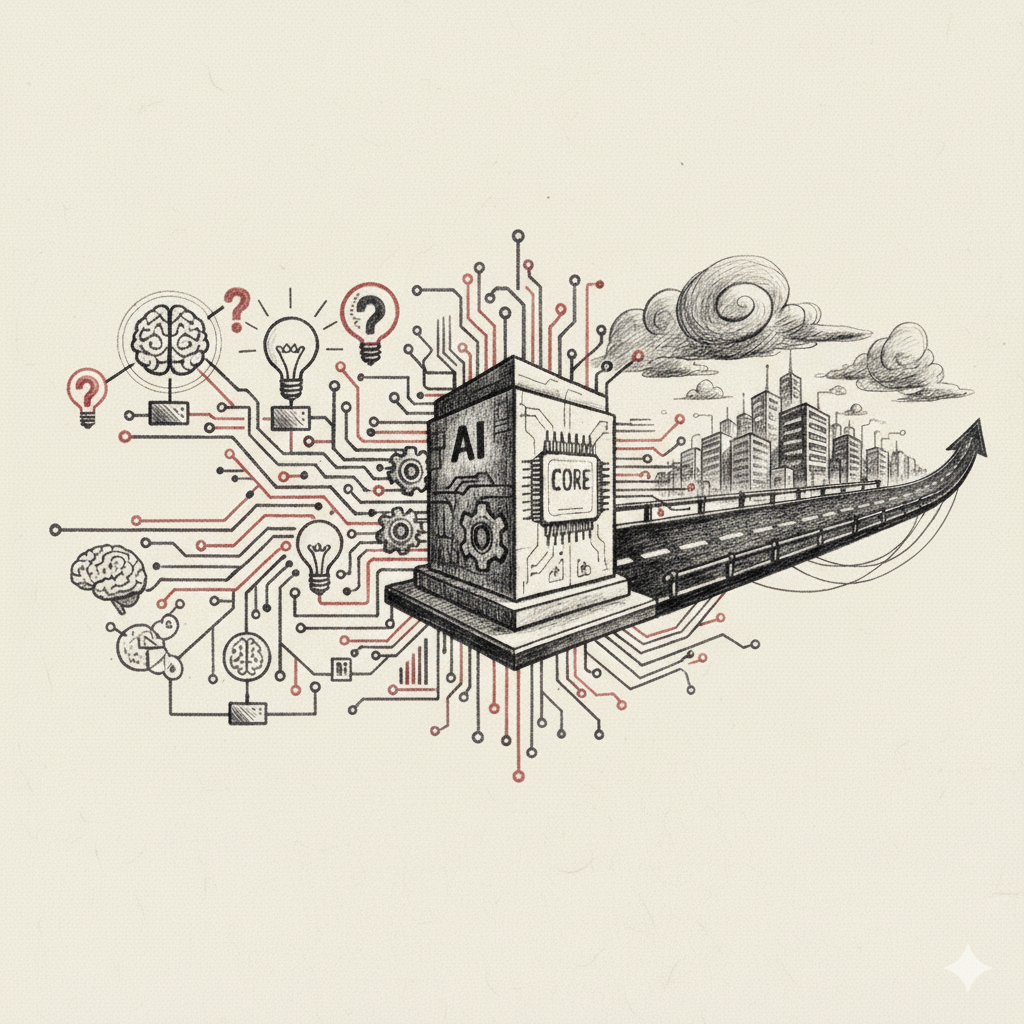From Hype to Reality: Building the Right AI Roadmap
Learn how to build an effective AI roadmap with expert strategy consulting, tailored AI solutions, and workflow automation that drive measurable business impact.

In today's fast-evolving technology landscape, many organizations feel pressure to adopt artificial intelligence. The buzz around generative AI, machine learning, and automation makes it tempting to rush into projects. But without direction, enthusiasm can quickly become wasted effort. That’s why a solid AI roadmap is essential: it moves initiatives from hype to reality.
A well-crafted AI roadmap guides your path with clarity. It aligns your AI investments with business goals, helps you evaluate use cases, and reveals the timing, dependencies, and resources you’ll need.
As 78 percent of organizations reported deploying AI by 2024, up from just 55 percent a year earlier, the trend is unmistakable. But many still struggle to generate consistent returns.
In this post, we will explore how to build a practical AI roadmap. The one that delivers results. We’ll draw on research and industry best practices, highlight real use cases, and explain how to work with an AI implementation partner or consulting team to accelerate outcomes.
Why You Need an AI Roadmap
Without a structured plan, AI projects are likely to stall, underdeliver, or misalign with business priorities. A comprehensive AI roadmap helps in several ways:
Strategic Alignment
A well-designed AI roadmap ensures that every AI initiative ties back to your organization’s core business goals. Instead of running isolated experiments, strategic alignment helps unify departments and ensures resources are channelled toward projects with clear business impact. When AI aligns with enterprise objectives, it strengthens ROI and fosters long-term sustainability.
Prioritization of Use Cases
Not every AI idea deserves immediate attention. Prioritizing AI use cases allows organizations to evaluate which projects offer the highest value and feasibility. This process includes assessing data readiness, technical complexity, potential ROI, and business urgency. Focusing on the right use cases first enables early wins and builds momentum for larger initiatives.
Resource Planning
Effective AI adoption requires the right mix of talent, tools, and partnerships. Resource planning helps organizations identify whether they need to develop internal expertise or collaborate with an AI implementation partner. It also clarifies infrastructure requirements and budget allocations. Strategic resource allocation ensures smooth execution and minimizes project bottlenecks.
Risk Mitigation
AI initiatives carry risks, including data bias, regulatory compliance, and change resistance. A strong AI roadmap allows organizations to anticipate and manage these risks early on. Implementing robust governance, ethical guidelines, and monitoring mechanisms ensures responsible AI use while building stakeholder trust.
Scalability
An AI roadmap provides a structured pathway from pilot projects to enterprise-wide adoption. It helps organizations plan for scaling models, managing performance, and integrating AI into core workflows. With scalability built into the roadmap, teams can continuously improve solutions, ensuring consistent performance as data and business needs evolve
There are seven workstreams within an AI roadmap framework: AI strategy, AI value, AI organization, people and culture, governance, engineering, and data. You don’t have to build every stream at once, but you must sequence and prioritize according to your maturity and business needs.
Steps to Build a Strong AI Roadmap
1. Define Your AI Vision and Strategy
Begin with a clear statement of purpose: What do you want AI to accomplish for your organization? Set guiding principles and measurable objectives. Many organizations already report that AI is fully integrated into their core business strategy.
Estimate your current AI maturity: how well prepared are you in terms of data, infrastructure, and internal skills. Use that insight to set realistic short-, medium-, and long-term goals. Partner with an AI consulting team if you lack experience in this area.
2. Identify and Prioritize AI Use Cases
Generate a list of candidate AI use cases by engaging domain experts, frontline teams, and external consultants. Examples might include predictive maintenance, customer churn prediction, intelligent document processing, or workflow automation in operations.
Score each use case by business value, technical feasibility, data availability, and cost. Then build a portfolio, start with low-risk pilots and scale those showing early success.
3. Plan Governance, Ethics, and Risk Management
AI brings risks such as bias, compliance, fairness, and model drift. Early governance is non-negotiable. Develop policies, ethical guidelines, decision rights, and auditing mechanisms. As you scale, formalize your governance structure and include monitoring tools such as model observability.
4. Build Data and Engineering Foundations
Reliable data is the backbone of AI. Assess your data readiness, including quality, label availability, integration, and data pipelines. Use practices such as data versioning, metadata, and observability.
In parallel, define reference architectures, decide when to build vs buy, set up sandbox environments, and plan for scalable infrastructure. Over time, pursue MLOps or ModelOps capabilities to support continuous deployment and monitoring.
5. Organize for Scale
As AI spreads, your organizational structure must adapt. Consider a central AI or analytics team, centers of excellence, or federated models. Plan for staffing and talent development; hiring specialists, upskilling existing teams, or outsourcing where needed. Embed change management to ensure adoption and culture alignment.
6. Execute in Phases and Iterate
Execute your roadmap by running pilots, measuring outcomes, and iterating. Use metrics such as ROI, accuracy, uptime, business KPIs (e.g. cost savings or revenue uplift). Document lessons learned and refine your roadmap. Scale use cases that deliver value while sunsetting those that don’t.
7. Integrate AI Solutions Across the Business
Once you validate pilots, expand the reach. Embed AI solutions into workflows, integrate with core systems, and enable automation at scale. Use AI automation services for repetitive tasks, workflow orchestration, and end-to-end implementations.
Real-World Use Cases That Validate an AI Roadmap
A thoughtful roadmap enables enterprises to deploy relevant use cases. Here are a few examples:
- Predictive Maintenance: In manufacturing, an AI model predicts machine failure before it happens. This reduces downtime and maintenance costs.
- Customer Service Automation: Intelligent chatbots and virtual assistants handle common queries, freeing agents for complex interactions.
- Supply Chain Optimization: Algorithms forecast demand, optimize inventory, and streamline logistics.
- Document Processing: AI extracts, classifies, and routes information from invoices, contracts, or claims.
- Fraud Detection: In finance, AI models monitor patterns and flag suspicious transactions dynamically.
These use cases illustrate how an AI roadmap ensures adoption of high-impact projects while managing complexity and cost.
How an AI Implementation Partner or Consulting Team Adds Value
Working with a reliable AI implementation partner or AI consulting team can accelerate your journey. Their contributions typically include:
- Domain expertise to help choose realistic use cases
- Technical architecture guidance
- Integration with legacy systems
- Governance and risk frameworks
- Talent support and knowledge transfer
You don’t hand over everything. Instead, use them to supplement your internal capabilities, especially in early stages or when scaling.
Overcoming Challenges and Common Pitfalls
Many organizations invest in AI prematurely. Some common challenges:
- Data silos and low quality: Poor or fragmented data impedes model performance
- Unclear value propositions: Without measurable ROI, initiatives lose support
- Lack of governance: Ethics, explainability, and regulation become afterthoughts
- Talent gap: Few organizations have full in-house AI skills
- Change resistance: People resist new processes unless clearly managed
However, companies that follow structured roadmaps fare better at delivering value. For example, although nmost of firms see AI as a priority, only few of them have generative AI in production.
Conclusion
In an era buzzing with AI hype, an AI roadmap is your anchor. It bridges the gap between ambition and execution. It lets you treat AI not as an experiment but as a strategic asset. From setting vision and prioritizing use cases to ensuring governance, engineering foundations, and scalable deployment, a roadmap keeps you focused and measured.
The statistics back the urgency. Over three-quarters of organizations now use AI in at least one business function. Yet many struggle to move beyond pilots. That’s where a roadmap, backed by an AI consulting team or implementation partner, provides structure, insight, and momentum.
Don’t let your AI ambition stall. Let’s talk or you can visit our website to learn how our AI roadmap services can help you deliver real results today and tomorrow.
Frequently Asked Questions (FAQ)
1. What is an AI roadmap, and why is it important?
An AI roadmap is a strategic plan that outlines how an organization will adopt, scale, and govern AI over time. It captures key milestones, use cases, resource requirements, and dependencies. Without it, AI efforts can become disjointed, unfocused, or fail to align with business objectives.
2. How do you choose which AI use cases to pursue first?
Start by generating a broad set of candidate AI use cases involving stakeholders across domains. Score them by business value, technical feasibility, and data readiness. Begin with low-risk pilots that deliver measurable impact, then scale or pivot as needed based on performance.
3. Can small or mid-sized companies benefit from an AI roadmap?
Absolutely. AI is not just for large enterprises. A well-designed roadmap helps small and mid-sized firms avoid wasted effort, maximize ROI, and scale intelligently. Engaging with the right AI automation services and partners helps manage cost and execution risk.
4. How do you measure success or ROI in AI projects?
Define metrics upfront aligned with business goals: e.g. cost reduction, increased revenue, error rate drop, or time saved. Also track model performance metrics like accuracy, latency, and uptime. Use dashboards, experiments, and A/B testing to validate whether AI is delivering the promised benefits.
5. What role does governance and ethics play in an AI roadmap?
Governance is critical. AI carries risks, like bias, transparency, privacy concerns, compliance, and model drift. From the start, your roadmap should include policies, roles, monitoring, and audit mechanisms. As systems scale, governance helps maintain trust, accountability, and alignment with regulation.



